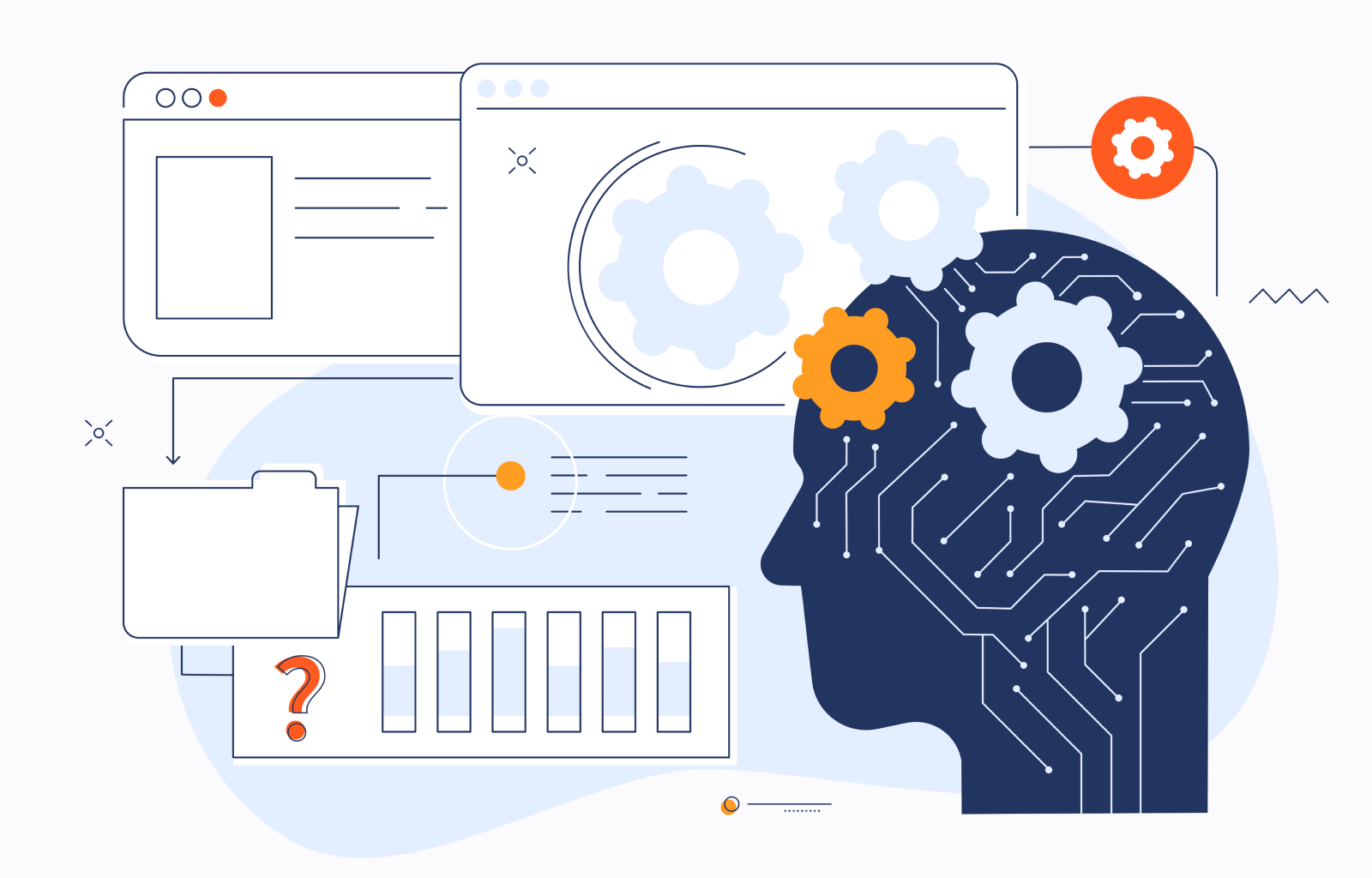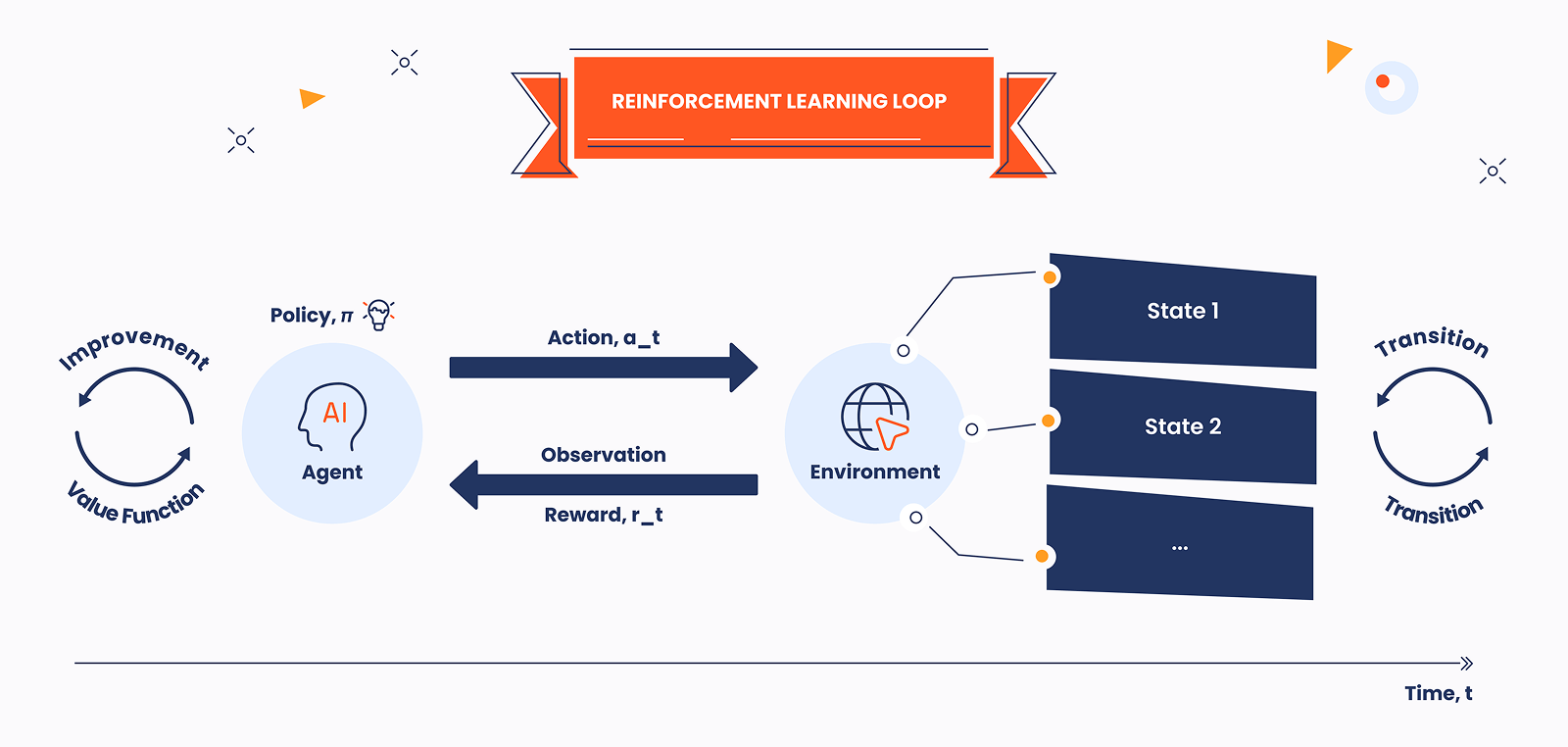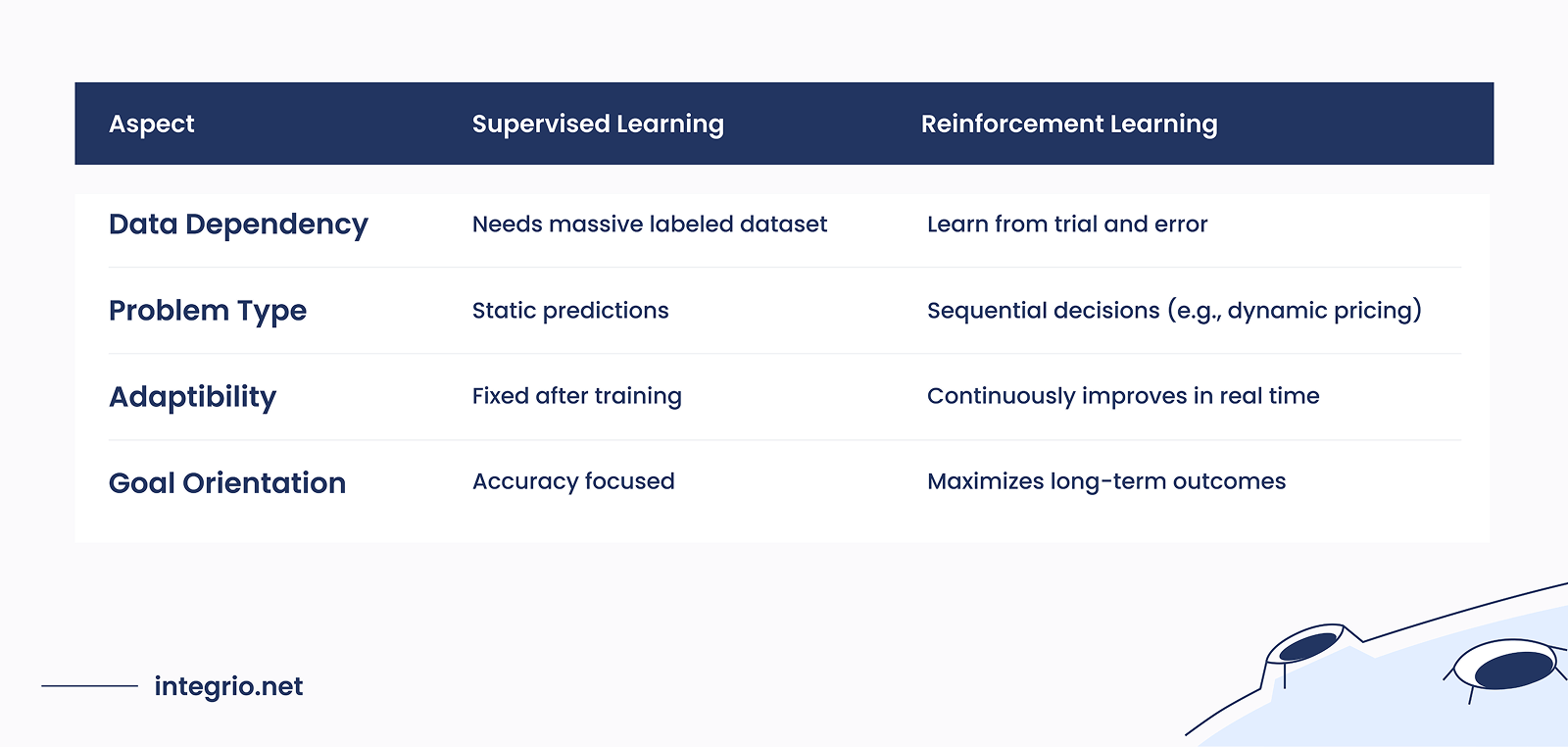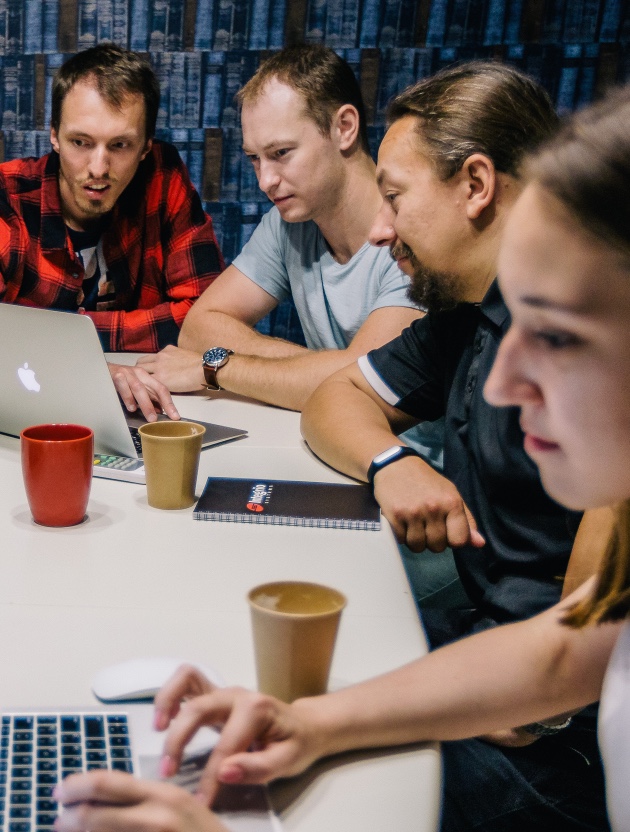Beyond the Labeled Data: How Reinforcement Learning is Revolutionizing IT Solutions

The Limits of Supervised Learning
In the world of AI, supervised learning has long been the workhorse, training models on labeled datasets to detect and classify objects, filter emails on spam, or predict customer behavior. But what happens when we face problems without predefined answers or when decisions must adapt dynamically to shifting environments? That’s where reinforcement learning (RL) emerges. Unlike its supervised counterpart, RL learns through interaction and consequence, making it uniquely suited for complex, real-time decision-making in IT ecosystems.
What is Reinforcement Learning?
Reinforcement Learning is a machine learning paradigm where a software decision-making component learns optimal behaviors by performing actions in an environment to maximize cumulative rewards. Think of it like training a dog: it tries different actions (sitting, jumping), receives feedback (treats or scolds), and refines its strategy to achieve goals. There are seven main components of such a system (fig. 1):
Agent. The AI software controller that makes the decisions. For example, it can manage the cooling system by adjusting fan speeds, coolant flow, or activating backup cooling units.
Environment. The world the agent operates in. For example, a data center with servers, cooling equipment, and sensors, where temperature and energy use change in response to the agent’s actions.
State (s). A snapshot of the environment at a given time. For example, current temperature readings from sensors, power consumption of cooling systems, and ambient temperature outside the data center.
Action (a). The actions the agent can take. For example, increase fan speed by 10%, redirect coolant to a hot zone, or activate backup chillers.
Reward (r). Immediate feedback based on the action. For example, temperature reduced without excessive energy use: +20, energy efficiency improved: +10, server overheats: -50, or high power use: -30.
Policy (𝝅). The agent’s strategy for choosing actions based on the current state. For example, "If CPU_temp > 70°C and ambient_temp > 20°C, increase fan speed by 20%."
Value function (v). Predicts the long-term cumulative reward from a state, helping the agent prefer efficient actions. For example, a stable, low-energy state might have a value of +100, while an overheating, energy-inefficient state could have -40.


Markov Models in Reinforcement Learning
Markov Decision Processes (MDPs) are the mathematical backbone of RL, framing problems where an agent's decisions impact future states. The core principle (the Markov Property) assumes the current state fully captures all relevant history for decision-making (i.e., "the future depends only on the present"). MDP formally define the interaction between an agent and its environment using states s, actions a, transition probabilities p(s′∣s,a), and rewards r(s,a). This framework enables RL algorithms to reason about long-term outcomes, balancing exploration and exploitation to maximize cumulative rewards. By modeling problems as MDPs, we can rigorously design and evaluate decision-making strategies in uncertain, dynamic environments.
Building on this theoretical foundation, we can explore specific RL algorithms that apply the MDP framework to real-world decision-making challenges.
Reinforcement Learning Algorithms From Theory to IT Operations
- Experience Replay. Stores and randomly samples past transitions to break correlation and stabilize learning.
- Target Network. A delayed copy of the network provides stable Q-value targets:
Target = R + γ maxₐ’ Q(s’,a’; θ⁻) - Loss Function. The network is trained to minimize:
L(θ) = [Target - Q(s,a; θ)]²
Multi-Armed Bandit (MAB). Optimizes immediate outcomes by balancing exploration (testing new alternatives) and exploitation (leveraging known top performers). Algorithms like ε-Greedy or UCB dynamically allocate resources to high-potential options in real time—reducing effort on underperformers while probing promising ones until statistical confidence is achieved. Typically delivers 5–15% better performance than traditional methods.
Example: An enterprise IT operations team could use MAB to intelligently route workloads across multiple cloud providers—automatically shifting traffic to maximize service reliability and minimize cost.
Q-learning. A reinforcement learning algorithm that builds a Q-table to estimate long-term values of actions in states. It updates values via:Q(s,a) ← Q(s,a) + α [R(s,a) + γ maxₐ’ Q(s’,a’) - Q(s,a)]
Learns purely from experience, gradually converging to optimal strategies even in dynamic environments without predefined rules.
Example: A logistics company could use Q-learning to optimize delivery routes in real time, adapting routes to traffic, weather, and time of day.
Deep Q-Network (DQN). Extends Q-learning by using neural networks instead of tables, allowing for optimization in high-dimensional state spaces like images or sensor data. It uses:
DQN enables learning in complex environments with techniques like gradient clipping and reward shaping to ensure stability.
Example: A manufacturing plant could use DQN to optimize robotic assembly. The system learns to adjust machines, schedule maintenance, and respond to new production scenarios—improving efficiency beyond what static rules could manage.
Policy Gradient Methods. These methods directly learn a parameterized policy π(a∣s;θ), optimized using gradient ascent:∇θJ(θ) ∝ E[∑∇θ log π(at∣st;θ) ⋅ A(st,at)]
They don’t require action-value estimation and are well-suited for continuous or stochastic action spaces.
Example: A customer support center could use policy gradients to route calls based on real-time data like sentiment analysis, wait time, and agent availability—learning policies that adapt as customer behavior shifts.
Proximal Policy Optimization (PPO). Improves policy gradients by enforcing conservative updates through a clipped objective:LCLIP(θ) = E[min( rt(θ) ⋅ At, clip(rt(θ), 1 - ε, 1 + ε) ⋅ At )]
where rt is the probability ratio between new and old policies.
PPO balances fast learning with stability and is widely used in modern RL applications.
Example: An asset management firm could use PPO for dynamic portfolio rebalancing, adjusting allocations as markets shift—without overreacting or incurring excess risk.
Actor-Critic Methods. Combine a policy-learning actor with a value-estimating critic. The actor updates its policy:∇θ J(θ) ≈ E[ ∇θ log π(at|st; θ) ⋅ At ]
And the critic updates value estimates by minimizing TD error:L(w) = (Rt + γ V(st+1; w) - V(st; w))²
The critic stabilizes learning by giving the actor real-time feedback.
Example: A trading firm could use Actor-Critic methods to learn profitable trading strategies that adapt to live market data—balancing exploration and exploitation in a constantly changing environment.
The Future of AI in Enterprise IT: How Reinforcement Learning is Changing the Game
Reinforcement Learning is a powerful type of artificial intelligence that’s moving far beyond the pure academic field and becoming a key tool for smarter, more efficient IT operations in businesses. Here’s a look at the latest breakthroughs and what they mean for your company’s technology and success.
Learning from Human Feedback
Instead of just following preset rules, some AI systems—especially large language models (LLMs) like GPT—learn by understanding what people prefer. Imagine training a virtual assistant not just by programming, but by having experts review and rank its answers, helping it get better over time. This approach, known as Reinforcement Learning from Human Feedback (RLHF), fine-tunes powerful language models to deliver responses that truly “get” what users want while keeping interactions secure and compliant. It’s already powering smart customer support chatbots and coding assistants that align closely with human needs.
Learning from Past Data Without Experimenting
Sometimes it’s too risky or costly to test AI decisions live. Offline Reinforcement Learning lets AI learn from old data—like server logs or past customer support tickets—so it can improve without trial and error. This helps companies spot issues faster, fix problems efficiently, and save money by optimizing resources using data they already have.
Teams of AI Agents Working Together
Imagine multiple AI “workers” collaborating across your network or supply chain, each managing different tasks but sharing info to make smarter overall decisions. This teamwork approach is helping optimize everything from internet traffic to warehouse robots, improving speed and reducing errors.
AI That Learns How to Learn
Some AI systems are designed to quickly adapt to new tasks without starting from scratch. This means a single AI could manage cloud resources across different providers, or adjust defenses automatically as new cyber threats appear. It’s like having an expert who can instantly master any new tool or environment.
Safe and Reliable AI
Safety is critical when AI controls important systems like power grids or industrial machinery. New methods make sure AI decisions stay within safe boundaries, avoiding costly mistakes and keeping operations smooth—even in unexpected situations.
AI Working Hand-in-Hand with Language Models
Large language models like GPT-4 can now work together with RL agents, planning strategies while letting RL handle real-time actions. This combo powers smart assistants that understand complex IT environments, helping with everything from fixing bugs to improving system performance.
Training AI in Virtual Worlds
Before deploying AI in real systems, companies use advanced simulations—virtual “test labs” that mimic real data centers or networks. These safe environments let AI practice handling challenges like power failures or network outages, to ensure that it’s ready for anything.
Looking Ahead: Smarter Infrastructure, Smarter Business
The future points to AI systems that don’t just follow instructions but learn and evolve with your infrastructure, making your IT smarter, safer, and more efficient every day. This shift will redefine how businesses operate, compete, and innovate.
How do we use advances from RL world to help business
The journey from requirements to solution begins with problem definition. First, we clearly articulate the business goals and formalize the problem to be solved. This includes specifying the desired outcomes and translating the problem into reinforcement learning terms. This is done by identifying the agents, environment, actions, states, and reward functions. At this stage, technical feasibility is assessed, including data availability and the possibility of creating a simulation environment.
A critical step is to thoroughly understand the available data and identify its variability to capture the nuances of the business process. To enable safe and efficient training, a simulation or emulated environment is developed, allowing the agent to learn without risking real-world operations. The data undergoes preprocessing, including normalization and feature selection, to construct meaningful states for the agent.
Next, an appropriate RL algorithm is selected based on the problem’s characteristics and constraints. Typical candidates include Q-learning, Policy Gradient methods, Actor-Critic architectures, DQN, PPO, or A3C. Initial prototypes are developed and evaluated to compare their performance, stability, and convergence speed. A plan for hyperparameter tuning is also established to optimize learning.
Following method selection, the model development phase begins. The RL agent is implemented with the chosen algorithm and integrated seamlessly with the environment. Training is conducted while continuously monitoring key metrics such as cumulative reward and policy stability to ensure robustness and reliability.
Once trained, the agent undergoes rigorous validation and testing within the simulated environment. Various scenarios are explored to assess generalization capabilities and uncover potential edge cases or failure modes. Performance is benchmarked against baseline strategies or existing solutions. When feasible, pilot deployments are carried out in controlled real-world or offline settings to validate the agent’s behavior before full-scale rollout.
Upon successful validation, the agent is deployed into production, integrated with existing business systems. Real-time monitoring tools are established to track agent decisions, key performance indicators, and detect anomalies promptly. Safety mechanisms and rollback procedures are implemented to manage unexpected behavior and mitigate risks.
Finally, the project enters a maintenance and iterative improvement phase. Continuous feedback from production data is analyzed to ensure alignment with business objectives. The model undergoes periodic retraining using fresh data, and both the agent and simulation environment are refined iteratively to enhance performance and adapt to evolving conditions.
FAQ
It can optimize pricing, marketing campaigns, logistics routes, and dynamic resource allocation in real time—especially in complex environments where decisions affect future outcomes. It also enables the development of precise and flexible models for dynamic pricing in various business scenarios.
Traditional analytics focus on predicting outcomes or classifying data based on static, labeled examples. Reinforcement learning, on the other hand, learns through trial and error—developing strategies that maximize long-term results. This makes RL especially powerful in dynamic, uncertain environments.
Yes. With simulations, transfer learning, or hybrid approaches, reinforcement learning can be applied even without large datasets. However, the environment must be well-designed to provide varied scenarios—otherwise, the agent may overfit and underperform in the real world.
RL agents optimize based on a reward system that defines what “success” looks like. If this reward function is poorly designed, the agent may find loopholes—achieving high rewards in ways that harm your business. In other words, if the agent is chasing the wrong metric, it can produce unintended and even dangerous results.
In fast-feedback environments like online advertising or real-time pricing, results may appear within weeks. For more complex domains like supply chain management or energy optimization, it can take 3–12 months of simulation, testing, and tuning before RL delivers a measurable return on investment.
Bonus
The most mature ecosystem to build RL-based solutions is related to Python ML stack. For instance,
- Stable-Baselines3. - Popular RL library with well-tested algorithms (PPO, A2C, DQN, etc.) [1]
- Ray RLlib. - Scalable RL framework for distributed training [2].
- OpenAI Gym / Gymnasium. - Standard API and environments for RL experimentation [3].
- PettingZoo. - Multi-agent RL environments [4].
- TensorFlow Agents (TF-Agents). - TensorFlow-based RL library [5].
- PyTorch RL Libraries. - Such as TorchRL and CleanRL for PyTorch-based workflows [6].
However, either Java (Deeplearning4j, RL4J) or .Net (Accord.NET, CNTK, ML.NET) have well-designed libraries to help professionals in developing the RL software.
Contact us

